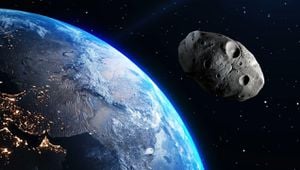The vastness of space continually captures the imagination, and as humanity pushes the boundaries of exploration, it has become fundamental to establish structures and missions that support these endeavors. Recently, an exciting development has emerged in the realm of space logistics as NASA gears up for its next resupply mission to the International Space Station (ISS). On August 4, 2024, Northrop Grumman’s Cygnus spacecraft will embark on its 21st commercial resupply mission, utilizing a SpaceX Falcon 9 rocket to deliver over 3.7 tonnes of supplies and scientific equipment to the station.
Included in this cargo are vital test materials and experiments aimed at furthering our understanding of life sciences and technological capabilities in space. Among the items set for delivery are essential test articles necessary for examining liquid and gas flow through innovative life support systems aboard the ISS. This investigation is crucial as we prepare for longer missions into deep space, where the sustainability of human life becomes an ever-pressing concern.
Students and young scientists will also get a chance to engage with the mission practically. A balloon, a penny, and a hexnut are included for a new STEMonstration focused on centripetal force, designed to spark interest in scientific inquiry among younger generations.
Additionally, the mission will include microorganisms known as Rotifers, which will be studied to observe the impacts of space travel on DNA repair mechanisms. This research is especially important given the potential genetic challenges that future astronauts might face on longer missions to destinations such as Mars.
The resupply mission also aims to demonstrate some groundbreaking biotechnologies. A bioreactor designed to produce high-quality blood and immune stem cells is among the equipment being delivered. Furthermore, vascularised liver tissue will allow scientists to analyze how engineered tissues develop blood vessels in microgravity conditions—a critical study in enhancing medical technology and potential treatments for terrestrial health issues.
NASA astronaut Matthew Dominick is scheduled to capture Cygnus using the ISS’s robotic arm, with Jeanette Epps as his backup. Following capture, the spacecraft will dock with the Unity module’s Earth-facing port, marking another significant step in international collaboration and scientific inquiry.
Also riding into orbit will be two CubeSats as part of NASA’s CubeSat Launch Initiative. These small satellites represent a triumph in educational outreach, encapsulating efforts to involve various universities in actual space endeavors. CySat-1, developed by Iowa State University, and DORA (Deployable Optical Receiver Aperture) from Arizona State University, contribute to a hands-on learning experience for students across the United States.
Post-delivery, the Cygnus spacecraft is poised to spend several months attached to the ISS before its departure in January 2025. Once the mission’s objectives have been fulfilled, Cygnus will re-enter Earth’s atmosphere, where it will burn up safely—a testament to the sustainable practices being seriously considered in modern space logistics.
Live coverage of the launch will commence on August 4 at 01:10 AM AEST across various platforms, including NASA Television and its website. The mission highlights not just the logistical capabilities required for space exploration but also the critical research being undertaken at the ISS, fostering a culture of inquiry and innovation deeply rooted in scientific exploration.
Looking beyond the launch, the broader space sector is witnessing significant developments. Recently, Equatorial Space has successfully secured pre-Series A funding, which will enable the company to enhance its focus on developing space technology solutions tailored for the unique challenges of orbital operations. This financial boost underscores the growing interest and investment in the space sector, reflecting a bustling ecosystem of startups working harmoniously with established aerospace giants.
In a related partnership, Teledyne Space Imaging has inked a significant deal to develop advanced space cameras, emphasizing the importance of high-quality imaging in reconnaissance and various scientific applications. This collaboration aims to enhance our capacity to monitor changes in Earth’s ecosystems and provide critical insights into our home planet's health.
The emphasis on sustainability and innovation was further echoed by Astroscale Japan’s recent successful fly-around of a space debris test unit. This endeavor is monumental in the ongoing fight against space junk, ensuring the safety and continuity of space operations. The increasing awareness and commitment to addressing space debris are essential, considering the potential hazards posed to both manned and unmanned missions.
Efforts in space logistics and sustainability are more urgent than ever as global interest in space exploration intensifies. As nations collaborate on ambitious projects like lunar missions and potential Mars exploration, the commitment to building a reliable infrastructure that supports these activities becomes critical. Innovations not only in technology but also in our approaches to safety, sustainability, and educational initiatives will lay the groundwork for future generations of explorers.
As part of this ongoing narrative, engaging the next generation remains a key pillar of space agencies’ missions. Educational programs aimed at involving students in real-world applications of space science are becoming integral to fostering interest in STEM fields, enabling future innovators and problem solvers to emerge from today’s classrooms.
In this confluence of various efforts within the space community, it is evident that the next chapter of space exploration is poised for exhilarating transformations, bringing humanity to new frontiers in its relentless quest for knowledge and discovery. Whether through launching resupply missions to support those living and working in orbit, engaging educational programs, or fostering collaborations that drive technological advancements, the road ahead promises prosperous and transformative journeys that will expand our understanding of the universe and our place within it.
This exciting juncture in history marks not just advancements in technology or science but also a profound shift in human aspirations and capabilities, as we continue to reach for the stars.



